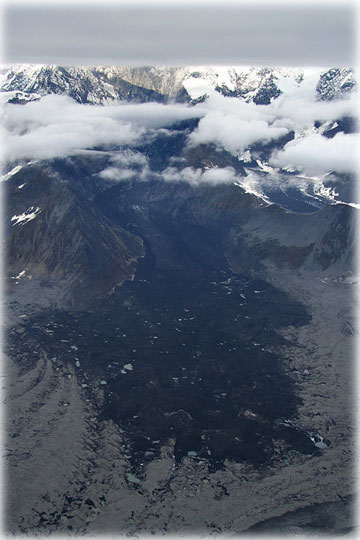 Alaska a hot topic in San
Francisco
Alaska a hot topic in San
Francisco
By Ned Rozell
January 10, 2007
Wednesday
While trolling the poster sessions at the Moscone Center in San
Francisco during the American Geophysical Union Fall Meeting
(attended by more than 13,000 scientists), a person bumps into
a great deal of information on Alaska. Here are some notes from
the legal pad:
 The collapse of a portion
of Mount Steller may have been caused by mysterious water flow
through snow and ice high on the 10,000-foot peak.
The collapse of a portion
of Mount Steller may have been caused by mysterious water flow
through snow and ice high on the 10,000-foot peak.
Ruedi Homberger photo, courtesy of Ultima Thule Lodge.
|
In September 2005, a massive rock avalanche on a remote mountain
peak registered on seismometers all over Alaska. Earthquakes
sometimes rattle steep mountains and cause avalanches, but no
earthquake preceded the collapse on Mount Steller, located about
80 miles east of Cordova. A scientist may have found the trigger
for the rock and snowslide that fell about 8,000 feet, sheared
off a glacier on the way down, and spewed black rock that extended
six miles from the mountain.
A year after the event, Bruce Molnia, a glaciologist with the
U.S. Geological Survey in Reston, Virginia, was looking at aerial
photos of Mount Steller and saw a hole in the surviving ice face
that didn't fall from the top of the mountain. The ice cave is
the mouth of a channel that probably held running water, Molnia
said.
"You don't get 30-meter holes on top of a mountain without
water flowing down," Molnia said.
Looking at the photos of Mount Steller and nearby peaks, Molnia
also saw evidence of two more water channels above other avalanche
sites. Somehow, he said, large amounts of water are flowing through
ice and snow at high altitudes in the area.
"(The avalanches) all seem to have an unusual meltwater
trigger," he said. "How can you get so much meltwater
at 3,000 meters?"
...
A scientist who has monitored temperatures in and around Barrow
since 2001 has found that the "urban" area of Barrow
averages 2 degrees Celsius warmer than the surrounding tundra
in the winter, and is sometimes 6 degrees warmer.
Ken Hinkel of the University of Cincinnati documented Barrow's
"heat island" with 70 instruments that have recorded
temperatures in and around Barrow once an hour since 2001. He
wanted to see if manmade warmth in Barrow had anything to do
with the fact that the snowmelt date at Barrow is now three weeks
earlier than it was in the 1940s.
Researchers have found heat islands in many other cities in America,
but Hinkel said that Barrow is different because there are few
vehicles there, which means that most of the heat measured must
be escaping from buildings in winter. He also said Barrow's heat
island disappears when there are high winds, and that the town's
heat island probably results in an eight percent reduction in
fuel bills during winter. As for the warmth generated by Barrow
residents affecting the earlier snowmelt date, he said it was
unlikely because the heat island is not as strong when the area's
snowpack is melting
in the spring.
. . .
University of Alberta researchers looked at ancient permafrost
at a placer mine along the Yukon River between Dawson City and
Whitehorse and determined that it had survived the peak warmth
of the planet's last great warm period, which was about 125,000
years ago. Some geologists thought that permafrost didn't survive
previous warm periods in Alaska's Interior.
"Reports of the death of permafrost in interior Alaska and
Yukon during the last (warm period between glacial periods) may
be greatly exaggerated," graduate student Alberto Reyes
wrote. "By analogy, deep permafrost is likely to persist
in the discontinuous permafrost zone, at least locally, despite
future global warming."
. . .
Martha Shulski of the Alaska
Climate Research Center at the Geophysical Institute recently
tallied up the mean annual temperature for Alaska locations in
2006, and Anchorage and Fairbanks were both cooler than normal.
Fairbanks was minus 25.8 degrees Fahrenheit, one degree colder
than normal, and Anchorage's mean annual temperature was 35.6
degrees; its yearly normal is 36.2 degrees Fahrenheit.
This column is provided
as a public service by the Geophysical
Institute, University of Alaska Fairbanks, in cooperation
with the UAF research community.
Ned Rozell [nrozell@gi.alaska.edu]
is a science writer at the institute.
E-mail your news &
photos to editor@sitnews.us
Publish A Letter on SitNews Read Letters/Opinions
Contact the Editor
SitNews
©2006
Stories In The News
Ketchikan, Alaska
|

